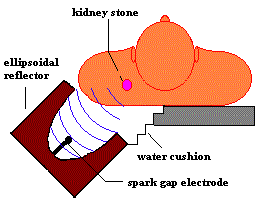H.T. Kurkjian, M.D.
ESWLHosted by OKdrs.com
_____________________________________________________________________________________
Dr. Kurkjian fast facts and information
[Kurkjian Home][Kurkjian FAQ][Kurkjian Services]
____________________________________________________________________________________
ESWL
(Extra Corporial Shockwave Lithotripsy)
 |
Extra Corporial Shockwave Lithotripsy (ESWL) is a procedure whereby urinary stones are broken using a special machine without surgery . A shockwave is generated in a water bath or a gel filled bag placed under the patient by producing a high voltage spark. This has the same effect as throwing a pebble in a pond and producing ripples on the water surface. As the shockwave travels through the human tissues it does not cause any significant damage. However as it meets a urinary stone it will break up crystals which the stone is made of. It may take up to two thousand shockwaves, or more, to complete the fragmentation. Sometimes, multiple stages become necessary. |
INDICATIONS
ESWL is best suited for stones in the kidney and kidney pelvis. The success rate for stones less than one inch in size is about ninety percent . Stones in the mid ureter and the lower ureter will break up in fifty percent of the cases.
PROCEDURE
Before ESWL it is customary to place a ureteral stent from the bladder to the kidney. This is a small caliber tube about the size of the tip of a lead pencil made of silicone. This tube will help localize the stone during the procedure since X-Ray is used to find the stone and bring it to the focus. After the procedure the stent helps the patient pass the fragments. This happens because the stent makes the ureter larger and the pieces pass by the stent more easily. The disadvantage of having the stent is that in some patients the tip of the stent which extends into the bladder can cause irritation and frequent urination. Since the stent has no valves as a normal ureter, urine may back up to the kidney specially during voiding and this can cause pain in the flank. At times the stent can cause blood in the urine. This will usually subside after a period of rest. Naturally the stent will have to be removed after the stone fragments pass. This is done by cystoscopy.
POST OP
After the patient wakes up from anesthesia he is taken to the recovery room where he will recover for about thirty minutes . Following that he will go back to patient holding where he can be seen by his family. Sometimes it is necessary to dismiss the patient with a foley catheter and a leg bag to be removed the next morning.
Disclaimer: Although OKdrs.com undertakes reasonable efforts to keep the information contained herein accurate, Okdrs.com does not warrant the accuracy, completeness, timeliness or merchantability or fitness for a particular purpose of the information contained herein nor in any way endorse the individuals described herein . In no event shall Okdrs.com be liable to you or anyone else for any decision made or action taken by you in reliance on such information. The above warranties are the only warranties of any kind either expressed or implied including warranties of merchantability or fitness for any particular purpose